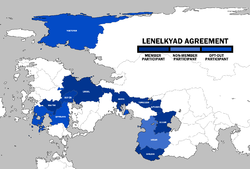Difference between revisions of "The Charter"
Valiiosanae (talk | contribs) (Added more sections and updated infobox) |
|||
| (One intermediate revision by one other user not shown) | |||
| Line 1: | Line 1: | ||
{{OOD}} | |||
{{Infobox country | {{Infobox country | ||
|micronation = <!--yes if a micronation--> | |micronation = <!--yes if a micronation--> | ||
| Line 159: | Line 160: | ||
===Founding=== | ===Founding=== | ||
The Charter was signed February 8, 1801 as an agreement between the [[Alotol Confederation]] and the [[Kingdom of Mai Thi]]. Its original aim was to cement Alotol-Maithic trade relations and offer mutual support to balance out regional spheres of influence. The Charter existed in this form until 1827 when the [[Kovat Kingdom of Asota]] joined the agreement. [[Asota]], [[Liosol]], and [[Mai Thi]] revised the original Royal Charter, making the aims of the agreement economic growth, social progress, regional peace, mutual assistance, and preservation of cultures in the region. This new Charter prompted the countries of ... to join. | The Charter was signed February 8, 1801 as an agreement between the [[Alotol Confederation]] and the [[Kingdom of Mai Thi]]. Its original aim was to cement Alotol-Maithic trade relations and offer mutual support to balance out regional spheres of influence. The Charter existed in this form until 1827 when the [[Kovat Kingdom of Asota]] joined the agreement. [[Asota]], [[Liosol]], and [[Mai Thi]] revised the original Royal Charter, making the aims of the agreement economic growth, social progress, regional peace, mutual assistance, and preservation of cultures in the region. This new Charter prompted the countries of ... to join. | ||
=== | ===Pangyeoun War=== | ||
{{main| | {{main|Pangyeoun War}} | ||
===Post-war policies=== | ===Post-war policies=== | ||
Following the Great Ekuosian War, members of the Charter created a mutual defence agreement, in case another major conflict occurred in the region. This agreement was put to the test during the [[Asotan Civil War]]. | Following the Great Ekuosian War, members of the Charter created a mutual defence agreement, in case another major conflict occurred in the region. This agreement was put to the test during the [[Asotan Civil War]]. | ||
Revision as of 10:26, 16 January 2023
 | This article or section is out of date. A country/countries relevant to this article have been removed from Sahar and have been retconned. Not everything here may still be considered canonical. This article was last edited by Arryog (talk | contribs) 14 months ago. (Update) |
The Charter
|
||||
|---|---|---|---|---|
|
||||
| Headquarters | Granas | |||
| Largest cities | Alotol City Çinabyen Limve Osgim | |||
| Type | Political and economic union | |||
| Membership |
3 observers
|
|||
| Leaders | ||||
| - | Secretary of CPS | |||
| - | Secretary of EPAC | |||
| - | Secretary of IBA | |||
| Establishment | ||||
| - | Treaty of the Namh River | 1801 | ||
| Population | ||||
| - | estimate | 258,075,000 (Member states only) 390,160,000 (Members and observers) |
||
| Currency | Various | |||
| Date format | yyyy/mm/dd | |||
| Internet TLD | .cu | |||
The Charter, officially The Royal Charter for Economic Cooperation in Trans-Miraria, is an economic and political union of 5 states in western Miraria. The mission statement of the Charter is to maintain free trade, freedom of movement, preserve cultural institutions, and promote peace in the region.
History
Founding
The Charter was signed February 8, 1801 as an agreement between the Alotol Confederation and the Kingdom of Mai Thi. Its original aim was to cement Alotol-Maithic trade relations and offer mutual support to balance out regional spheres of influence. The Charter existed in this form until 1827 when the Kovat Kingdom of Asota joined the agreement. Asota, Liosol, and Mai Thi revised the original Royal Charter, making the aims of the agreement economic growth, social progress, regional peace, mutual assistance, and preservation of cultures in the region. This new Charter prompted the countries of ... to join.
Pangyeoun War
Post-war policies
Following the Great Ekuosian War, members of the Charter created a mutual defence agreement, in case another major conflict occurred in the region. This agreement was put to the test during the Asotan Civil War.
During the 60's, the city Agreement was enacted, allowing freedom of movement between Asota, Huy En, Liosol, Mai Thi, and Lenezan. This was later expanded to include non-member countries in Soltenna and Vaniua.
Structure
Historically, the Charter has no formal legislature or governing body. Instead, members of the members' governments work in different agencies and meet multiple times throughout the year in Granas. While there is no designated leader of the Charter, the Secretary of CPS is typically considered the de jure head of the organization.
CPS
Established in 1832 as the first major agency of the Charter, the Cultural Preservation Society (CPS) strives to provide an outlet for historically important cultural values and protect national sites, treasures, and individuals from being destroyed by outside influence.
EPAC
The Economic Policy Association of the Charter (EPAC) played a major role in trade between the countries in the Charter during the imperial era. It has in recent years been superseded by the Soltennan Council, although many of the EPAC's economic initiatives remain in place for some of the Charter members.
IBA
The International Body of Advocates (IBA) is the Charter's progressive agency, working on behalf of LGBTQ+ individuals, immigrants, and other species to secure their rights in both Charter states and surrounding countries. The IBA has drawn much ire from the international community, especially from countries that are opposed to equal rights for people in the LGBTQ+ community.

